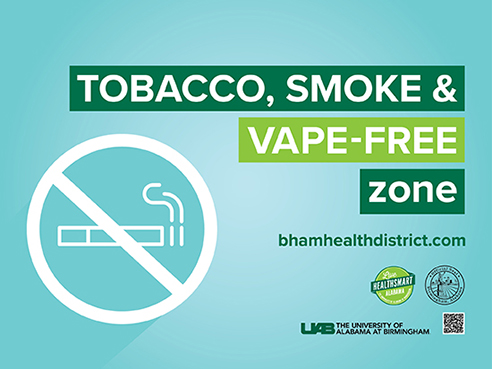 The smoke-free Health District, created by a Birmingham City Council ordinance in October 2019, has launched. This ordinance (No. 19-159) supplements UAB policies and makes the vast majority of UAB campus — both inside and outside — a smoke-free zone.
The smoke-free Health District, created by a Birmingham City Council ordinance in October 2019, has launched. This ordinance (No. 19-159) supplements UAB policies and makes the vast majority of UAB campus — both inside and outside — a smoke-free zone.
Smoking is prohibited on public property – including city streets and sidewalks within the Health District. A new website provides FAQs, links to smoking-cessation resources and other information to help smokers and non-smokers navigate the new law; access it at bhamhealthdistrict.com/ready-to-quit/.
“The university campus has had a smoke-, tobacco- and vape-free policy since 2015, but smoking was permitted on adjacent Birmingham-owned streets and sidewalks,” said Assistant Vice President for Student Health and Wellbeing Rebecca Kennedy, Ph.D. “The new ordinance now prohibits smoking in adjacent public spaces, which is a game-changer as we work to create a healthier campus community for all.”
At this time, a limited number of designated smoking areas permitted by the ordinance will be offered at UAB Hospital and Highlands Hospital, where information and resources to help people quit smoking will be promoted.
To promote a smoke- and tobacco-free campus, including e-cigarette and vape, UAB will increase signage, communications and resources in the coming months to help students, faculty, staff, patients and others quit smoking and provide encouragement and support to others.
“UAB and our partners that advocated for the Health District believe it is important that we use the Health District to create a positive culture around wellness and a healthy, smoke-free environment,” said Susan Walley, M.D., a professor in the UAB Department of Pediatrics. “It is our hope that, with improving access to tobacco-quitting resources, information and changing social norms, the Health District will make a difference in decreasing the tobacco use and exposure to tobacco smoke in Alabama.”
With more than 22,000 students, 23,000 faculty and staff, and more than 1.5 million annual patient visits plus other visitors, UAB sees the Health District as an opportunity to reach and help countless people.
Ready to go smoke-free?
• Resources for employees The UAB Employee Assistance & Counseling Center provides a variety of free tobacco-cessation services for employees, including group and individual counseling, plus online apps and other resources to help you succeed. The next group session starts Feb. 6.
• Resources for all The Alabama Tobacco Quitline is a free telephone and online coaching service for any Alabamian; call 1-800-QUIT-NOW or visit quitnowalabama.com for information, referrals and confidential coaching that is convenient for you. Eligible residents may receive up to eight weeks of nicotine replacement therapy patches.
“UAB recently launched Live HealthSmart Alabama with the goal of significantly improving the health of Alabamians,” President Ray Watts said. “This Health District is one of the many initiatives we will advance through our unique ability to make our state healthier through our focus on education, research, innovation and economic development, patient care and community service.”
Partners in the Health District initiative include the City of Birmingham, Children’s of Alabama, Cooper Green Mercy Health Services, Jefferson County Department of Health, Southern Research, UAB, UAB Medicine and Veterans Affairs Medical Center.
More than 2.5 million of the 20-plus million Americans who died because of smoking in the past 50 years were non-smokers affected by secondhand smoke, according to the U.S. Surgeon General.
“There is no safe level of secondhand smoke; being tobacco and smoke-free is one of the single best things you can do for your health,” Walley said. “If you or someone you know is ready to quit smoking, there are resources available.”
To learn more about the dangers of smoking, read the Surgeon General’s Report on Smoking and Health.
